

Vol. 40 (Number 10) Year 2019. Page 21
BERSHITSKIY, Yuriy Iosifovich 1; SAFONOVA, Margarita Fridrikhovna 2 & SAYFETDINOV, Aleksandr Rafailovich 3
Received: 13/02/2019 • Approved: 15/03/2019 • Published 31/03/2019
ABSTRACT: A method of substantiating areas and assessing the economic efficiency of the innovative development of the region's meat cattle breeding, based on the construction and analysis of boundary production functions and taking into account the size and heterogeneity of the resource base of producers, is proposed. The results of the economic analysis of indicators of cattle meat production in agricultural organizations of one of the leading agricultural regions of Russia - the Krasnodar Territory. Performance indicators were calculated, and potential volumes of cattle meat produced in the region were identified using the proposed methodology. The analysis of the factors that determine the level of technical, allocative and economic efficiency of meat cattle breeding in the Krasnodar Territory is carried out, and the directions of innovative development of this sub-industry were determined from it. |
RESUMEN: Se propone un método para fundamentar áreas y evaluar la eficiencia económica del desarrollo innovador de la cría de ganado de carne de la región, basado en la construcción y análisis de las funciones de producción de límites y teniendo en cuenta el tamaño y la heterogeneidad de la base de recursos de los productores. Se presentan los resultados del análisis económico de los indicadores de la producción de carne de ganado en organizaciones agrícolas de una de las principales regiones agrícolas del Territorio de Krasnodade Rusia. Se calcularon los indicadores de desempeño y se identificaron los volúmenes potenciales de carne de ganado producido en la región utilizando la metodología propuesta. se determinaron a partir de él Se lleva a cabo el análisis de los factores que determinan el nivel de eficiencia técnica, de asignación y económica de la cría de ganado de carne en el Territorio de Krasnodar, y las direcciones de desarrollo innovador de esta sub- industria. |
From 1990 to 2017, the number of cattle in the agricultural organizations of Russia was continuously reduced, due to the weakening of state support for the industry and a decrease in its resource potential. By 2017, the share of imported commodities in the Russian meat market reached 40%, with the country being almost entirely self-sufficient in poultry and pork meat. One of the main reasons for the current situation is the low profitability of cattle meat production due to the relatively low productivity of animals and the high cost of production.
At the same time, the primary production and economic indicators in the Russian meat cattle breeding sub-industry vary significantly among different producers. For example, in recent years, the live weight of sales of one head of cattle to processing enterprises ranged from 200 to 500 kg for various agricultural organizations. This is justified by the low productivity of the breed composition of animals used in most agricultural organizations, the use of outdated technologies of herd reproduction and fattening. Therefore, the compilation of international experience and the experience of advanced domestic producers will improve the efficiency of meat cattle breeding, increase production volumes, thereby reducing the country's import dependence on this food type.
There are works on assessing the economic efficiency of beef cattle in Western countries, using various methodological approaches (Ceyhan and Hazneci; 2010; Otieno et al., 2012; Rakipova et al., 2003). However, similar studies of the efficiency of beef cattle in Russia are practically absent.
In this regard, the purpose of this work is to refine and adapt the existing methodological tools to the modern features of the production of cattle meat in the regions of Russia.
The method for constructing and analyzing boundary production functions based on the methodical approach proposed by Farrell (1957) is the basis for evaluating the effectiveness of the functioning of the sub-industry of beef cattle. The basis of his idea was the assertion that an economic entity can be considered cost-effective only if it produces commodities to the maximum possible extent with the technology used and the available resource base.
The economic efficiency of production can be divided into two components: technical and allocative. Technical efficiency is defined as the ability of a commodity producer in using the technology to produce the maximum possible volume of commodities from a given amount of production resources or to achieve a particular volume of production with minimal production costs. Allocative efficiency is defined as the ability to use it in the production of commodities, the optimal structure of production resources, taking into account the prevailing pricing environment.
Figure 1, which illustrates the unit costs of x1 and x2 production resources in the production of a single type of commodity y, gives a visual representation of the essence of technical, allocative and economic efficiency.
In the figure, the SS' curve (isoquantum) shows the minimum possible unit costs of х1 and х2 production resources, and producers who have reduced their unit costs of resources to this minimum level will be considered technically efficient. Straight line AA' (isocost) shows possible combinations of х1 and х2 production resources, the value of which is constant.
Figure 1
Graphic interpretation of the technical, allocative and economic efficiency of
the commodity producer when it is oriented towards reducing production costs
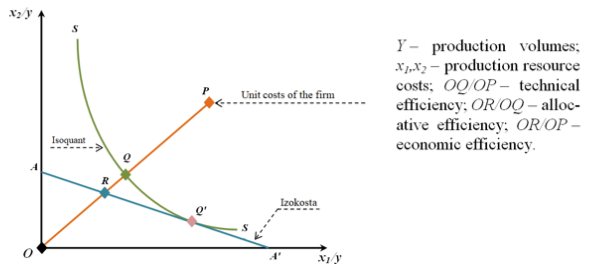
The value of the technical efficiency of an enterprise with specific resource costs corresponding to point P in Figure 1 is equal to the ratio of OQ/OP segments' lengths, which indicates the possibility of reducing the cost of resources without reducing production volumes or degrading the quality of commodities. The allocative efficiency is represented by the ratio of OR/OQ segments' lengths, which shows a possible reduction in production costs when moving production volumes from the technically effective point Q to the technically and allocativelly effective point Q'. Economic efficiency is defined as the production of technical and allocative estimates of efficiency, with RP/OP ratio indicating a possible overall reduction in production costs (Coelli, 1995).
Figure 1 reflects the essence of technical, allocative and economic efficiency with an orientation towards reducing the costs of material and financial resources for a given production volume. However, assessments of technical, allocative, and economic efficiency with such a methodical approach will not always accurately reflect the possibilities of increasing production volumes.
Figure 2 shows a graphical interpretation of the technical efficiency of a commodity producer, with its orientation towards the growth of production volumes for a given volume of production resources.
Figure 2
Graphical interpretation of the technical efficiency of the
enterprise with a focus on the growth of production volumes
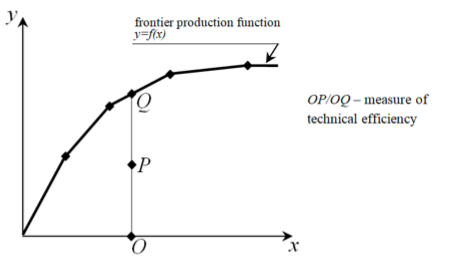
It is proposed to use a boundary concave non-decreasing production function constructed using non-parametric techniques when focusing on increasing production volumes for calculations of the producer's technical efficiency.
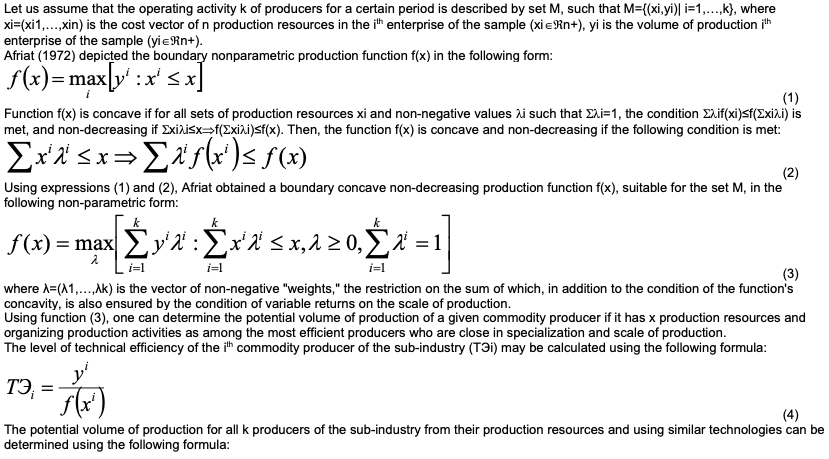
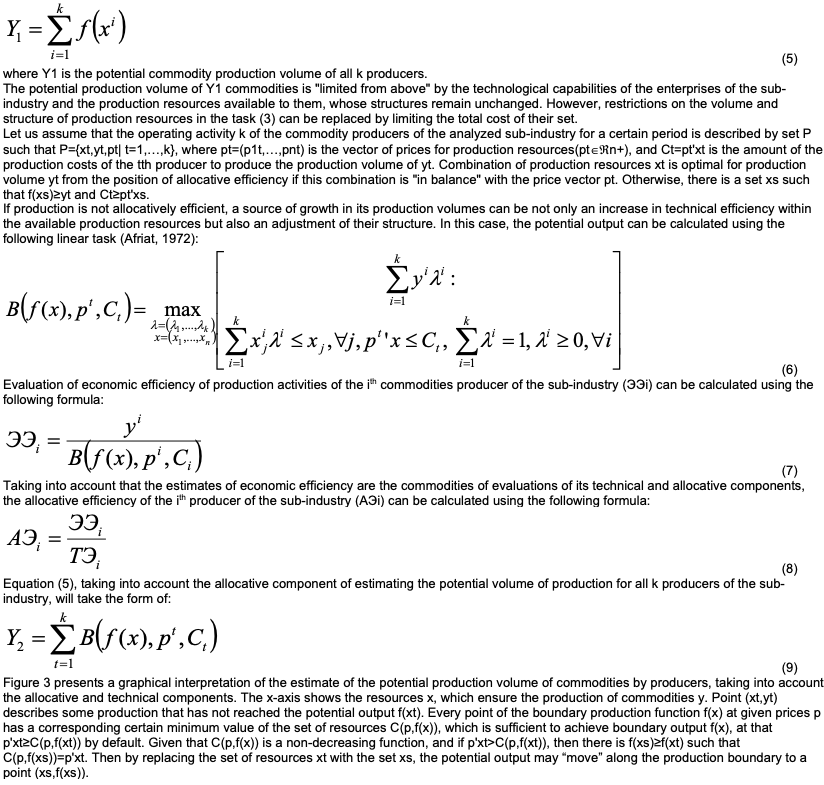
Figure 3
Graphic interpretation of the assessment of the potential production volume,
taking into account the technical and allocative components of economic efficiency
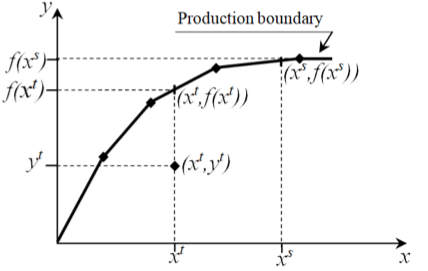
In the considered method, the potential for increasing the volume of production for individual producers is determined by the performance indicators of the leading producers in the sub-industry. The number of economic entities included in the sample under study affects the boundary characteristics of the best of them, shifting them in one direction or another. In the formation of samples of producers used to construct production functions, it is necessary to consider the following conditions: the assumption of the using the general production technology for all the producers included in the sample and the homogeneity of the production resources used by them.
The task (6) allows perfect elasticity of the supply of production resources in the region. However, when it comes to a sufficiently large group of producers or an entire sub-industry, then changes in the volume and structure of production resources used also cause changes in their prices in the market, and sometimes they may not be feasible due to the shortage of some of their species in the region.
To solve this problem, the authors propose to combine model (6) with a particular model of the market of productive resources, imitating their structural, dimensional and price changes (Bershitskiy and Sayfetdinov, 2016).
In this case, the potential production volume in the group of producers, taking into account the technical and allocative components of economic efficiency and available production resources, can be determined by solving the following linear problem:

The result of solving the problem (10) is potentially possible production volumes of m producers conducting economic activities in some territorial boundaries of the region, with the most efficient use of their production resources. It is assumed that business entities may have any other structural and volumetric composition of production resources under the current pricing environment. The correctness and adequacy of the developed methodology were tested in evaluating the effectiveness and substantiation of the directions for the development of beef cattle breeding in one of the leading agricultural regions of Russia - the Krasnodar Territory.
The livestock of cattle in Russia in recent decades has demonstrated a negative trend: in 2017, there were 19.2 million heads, which accounted for 35% of the level in 1991 (Table 1). At the same time, the 90s of the transition to a market economy were the most destructive for domestic cattle breeding, when the number of cattle in farms of all categories of the country was halved. Since 2005, the rate of decline in livestock began to slow down, and in some years of this period, even its growth was noted.
In the same period, there were noticeable structural changes in the distribution of cattle livestock by groups of producers. Most of all, the livestock of this species has declined in agricultural organizations.
In the period from 1991 to 2017, the production of cattle live weight in farms of all categories of the country has more than halved to 2.8 million tons.
Table 1
Livestock and production volumes of
cattle live weight gains in Russia
Indicator |
1991 |
2000 |
2010 |
2017 |
2017 in % to 1999 |
Cattle livestock, thous. heads |
54,677 |
27,520 |
19,968 |
19,253 |
35.2 |
Including: in agricultural organizations |
43,911 |
16,509 |
9,257 |
8,295 |
18.9 |
in peasant (farming) economies |
112 |
543 |
1,476 |
2,691 |
in 24 times |
in population farms |
10,654 |
10,468 |
9,236 |
8,267 |
77.6 |
Production volumes of cattle meat in live weight, thousand tons |
6,361 | 3,212 |
2,968 |
2,826 |
44.4 |
Including: in agricultural organizations |
4,551 |
1,374 |
1,003 |
938.5 |
20.6 |
in peasant (farming) economies |
0 |
59 |
177 |
255.3 |
– |
in population farms |
1,810 |
1,780 |
1,789 |
1,632 |
90.2 |
Similar negative dynamics in the production of cattle meat was observed in the Krasnodar Territory. Cattle livestock in the agricultural organizations of the region from 2000 to 2017 decreased from 737 to 352 thousand heads or 2.1 times. During this period, the production of cattle meat decreased from 78 to 48 thousand tons or 1.6 times (Table 2).
The values of the principal specific production indicators in the region's beef cattle breeding remain low compared with the level typical for leading agricultural organizations in the country specializing in the fattening of animal meat breeds.
The insufficiently high level of these indicators is one of the main reasons for the loss of production of cattle meat in the region.
Table 2
Production and economic indicators of beef cattle in agricultural
organizations of the Krasnodar Territory, 2000–2017
Indicator |
2000 |
2010 |
2017 |
2017 in % to 2000 |
Cattle livestock, thous. heads |
737 |
440 |
352 |
47.8 |
Including cows: |
279 |
164 |
132 |
47.3 |
Production of cattle meat in live weight, thousand tons |
78 |
64 |
48 |
61.5 |
The output of calves per 100 cows, heads |
78 |
72 |
70 |
89.7 |
Average daily weight gain of cattle, g |
437 |
619 |
642 |
146.9 |
Average live weight of sales of one head of cattle, kg/head |
344 |
351 |
365 |
106.1 |
The production cost of cattle meat, rubles/kg |
30 |
83 |
142 |
in 4.7 times |
Unprofitable sales of commodities, % |
-36 |
-26 |
-30 |
‑ |
Calculations of indicators of technical, allocative and economic efficiency of production of cattle meat were carried out based on the results of production activities of 165 agricultural organizations of the Krasnodar Territory, engaged in 2017 in breeding and fattening cattle. For this, 652 linear programming tasks (3) and (6) were solved. The analysis of the results showed that a significant part of the agricultural organizations in each agro-climatic zone of the Krasnodar Territory is technically efficient (34, 32 and 11 producers in the North, Central and South Piedmont zones, respectively). The weighted average values of technical efficiency indicators indicate that the agricultural organizations of the Krasnodar Territory, engaged in the production of cattle meat, have the potential to increase production volumes.
Currently, in the region, more than 90% of cattle weight gain is produced from dairy animal breeds. At the same time, it has been established that even if the breed composition of livestock and the applied technologies of reproduction, rearing, fattening and the prevailing price situation are maintained, the production of cattle meat in the region may be increased by 11.4 thousand tons or by 22.5% due to livestock, optimizing the structure of feed rations of animals of different age and sex groups, as well as the complete mechanization and automation of production processes (Bershitskiy and Sayfetdinov, 2016).
Studies also showed that it is possible to significantly improve the efficiency of the cattle breeding of the region by providing the breeding stock and young animals in the early stages of the production cycle with cheap pasture feed. In this case, the cost of gains in live weight of cattle can be reduced by more than 25% (Bershitskiy and Sayfetdinov, 2017).
The experience of countries with developed beef cattle and selected advanced Russian agricultural enterprises engaged in cattle meat production has shown that to speed up the formation and reproduction of cattle herd, it is economically feasible to apply artificial insemination of cows by elite meat breeds, which allows up to 90% of male calves for subsequent rearing and final fattening. The calculations showed that insemination of up to 70% of cows using this innovative technology will not only accelerate the processes of formation and reproduction of a highly productive herd of cattle but also significantly reduce the amount of investment in the replenishment and renewal of brood-stock of expensively imported animals of beef breeds (Bershitskiy and Sayfetdinov, 2017).
Comparative evaluation of the effectiveness of various areas and forms of state support for animal husbandry in the Krasnodar Territory over the last 5–7 years has shown that the state budget funds have the highest return in compensating part of the industry's production costs, as well as subsidizing part of the interest rate on investment loans (Bershitskiy et al., 2016). Taking this into account, the government recommends partial reimbursement of expenses for the purchase of imported heifers and heifers of elite beef breeds divided by sex and bull seed for reproductive farms and complexes, as well as for subsidizing part of the interest rate on bank investment and short-term credits allocated to the construction and organization of the functioning of livestock production facilities.
The results of the research allowed performing calculations of the forecast indicators of the medium-term development of the sub-industry of specialized meat cattle breeding in the Krasnodar Territory, presented in Table 3.
Table 3
Forecast indicators of the medium-term development of the sub-industry
of specialized meat cattle breeding in the Krasnodar Territory
Indicator |
Value at the beginning of 2017 |
Forecast for 2026 |
Cattle average annual livestock in agricultural organizations, thous. heads |
352 |
434 |
Including meat and cross-breeds, thous. heads |
24 |
192 |
Of them breeding stock |
8 |
40 |
fattening calves |
3.8 |
74 |
The share of meat cattle in the total number of cattle, % |
6.8 |
44.0 |
Production volumes of cattle meat in agricultural organizations, thousand tons |
48 |
74.6 |
Including from fattening animals of meat and cross-breeds thousand tons |
3.7 |
60.9 |
The average cost of production of cattle meat, rubles/kg |
142 |
120 |
The average selling price of the live weight of cattle, rubles/kg |
100 |
147 |
Production profitability, % |
-30 |
22 |
Analysis of the forecast results shows that the practical implementation of economically sound organizational, economic and technological measures will increase the number of cattle from 20 to 192 thousand heads by 2026 and increase the share of meat cattle in the total livestock from 7 to 44%. This will ensure an increase in the production of cattle meat in the region by 26.6 thousand tons or 55%, a reduction in production costs by 15%, which, in turn, will allow overcoming the current unprofitability of production in the sub-industry and bring its profitability to 22%.
In order to assess the economic efficiency of meat cattle breeding in the region, an author’s methodical approach is proposed based on comparing the parameters of boundary production functions determined by the results of production and economic activity of the most efficient economic entities engaged in feeding cattle and having close to optimal scales of industry production and the structure of production resources the moment of calculation of price conjuncture.
An analysis of the state of the meat cattle breeding sub-industry in the Krasnodar Territory in 2017 showed that more than 90% of the production of cattle meat in the agricultural organizations of the region produces dairy breeds from livestock. Analysis of the parameters of the boundary production function, based on the results of economic activities of 165 agricultural organizations of various climatic zones of the Krasnodar Territory engaged in the production of cattle meat, showed that only in 17 of them the production of this type of commodity is cost-effective. The analysis also showed that even with the existing production technology and the prevailing price situation, the volume of production in the sub-industry could be increased by 11.4 thousand tons or 22.5% due to a more rational use of production resources and optimization of their structure.
It is economically most efficient to organize the processes of formation and reproduction of the herd for the production of cattle meat using the technology of artificial insemination of cows with the bull-seed of elite meat breeds divided by sex. This will ensure the rapid growth of the livestock of highly productive animals of mixed and meat breeds for fattening and significantly reduce the amount of investment in the replenishment and repair of expensively imported breeding stock of animals.
Comparative evaluation of the effectiveness of various areas and forms of state support for livestock in the Krasnodar Territory allowed to justify the priorities of such support in the formation and development of the specialized meat cattle breeding sub-industry, which included targeted subsidies for the purchase of elite meat cattle breeds for reproductive farms and complexes divided by the sex of the seed bulls, as well as subsidizing part of the interest rate on bank investment and short-term loans, for the construction and organization of the operation of livestock facilities.
Calculations of indicators of the medium-term forecast of the development of the sub-industry of meat cattle breeding in the Krasnodar Territory, made using the results of the present study, showed that the implementation of the proposed and economically sound measures will increase the cattle stock of meat breeds from 2426 to 106 thousand heads and mixed breeds - up to 53 thousand heads. This, in turn, will ensure an increase in the production of cattle meat in live weight from 3.7 to 61 thousand tons at an average cost of 100–120 rubles/kg.
AFRIAT, S.N. (1972), Efficiency estimation of production functions. International economic review. Vol 3, page 568-596.
BERSHITSKIY, Yu.I., SAYFETDINOV, A.R. (2016). Economics of the formation and development of specialized meat cattle breeding in agricultural organizations of the Krasnodar Territory: a monograph. Krasnodar: Kuban State Agrarian University.
BERSHITSKIY, Yu.I., SAYFETDINOV, A.R. (2017). Directions for improving the efficiency of meat cattle breeding in the Krasnodar Territory. Economics of Agriculture of Russia. Vol 5, page 54–59.
BERSHITSKIY, Yu.I., TYUPAKOV, K.E., SAYFETDINOVA, N.R., SAYFETDINOV, A.R. (2016). The effectiveness of state support for agricultural producers of Krasnodar Territory. Economics of Agriculture of Russia. Vol 9, page 30–36.
CEYHAN, V., HAZNECI, K. (2010). Economic efficiency of cattle-fattening farms in Amasya Province, Turkey. Journal of animal and veterinary advances. Vol 9, page 60-69.
COELLI, T.J. (1995). Recent developments in frontier modeling and efficiency measurement. Australian Journal of Agricultural Economics. Vol 3, page 219-245.
FARRELL, M.J. (1952). The measurement of productive efficiency. Journal of the Royal Statistical Society, Series A (General). Vol 3, year, page 253-290.
OTIENO, D.J., HUBBARD, L., RUTO, E. (2011). Technical efficiency and technology gaps in beef cattle production systems in Kenya: A stochastic meta-frontier analysis. The 85th annual Conference of the Agricultural Economics Society (AES), 18-20 April 2011. Warwick: University of Warwick.
RAKIPOVA, A.N., GILLESPIE, J.M., FRANKE, D.E. (2003). Determinants of technical efficiency in Louisiana beef cattle production. Journal of the ASFMRA. page 99-107.
1. Kuban State Agrarian University, 13 Kalinina Street, Krasnodar, Russian Federation
2. Kuban State Agrarian University, 13 Kalinina Street, Krasnodar, Russian Federation, marharyta.safonova@yandex.ru
3. Kuban State Agrarian University, 13 Kalinina Street, Krasnodar, Russian Federation